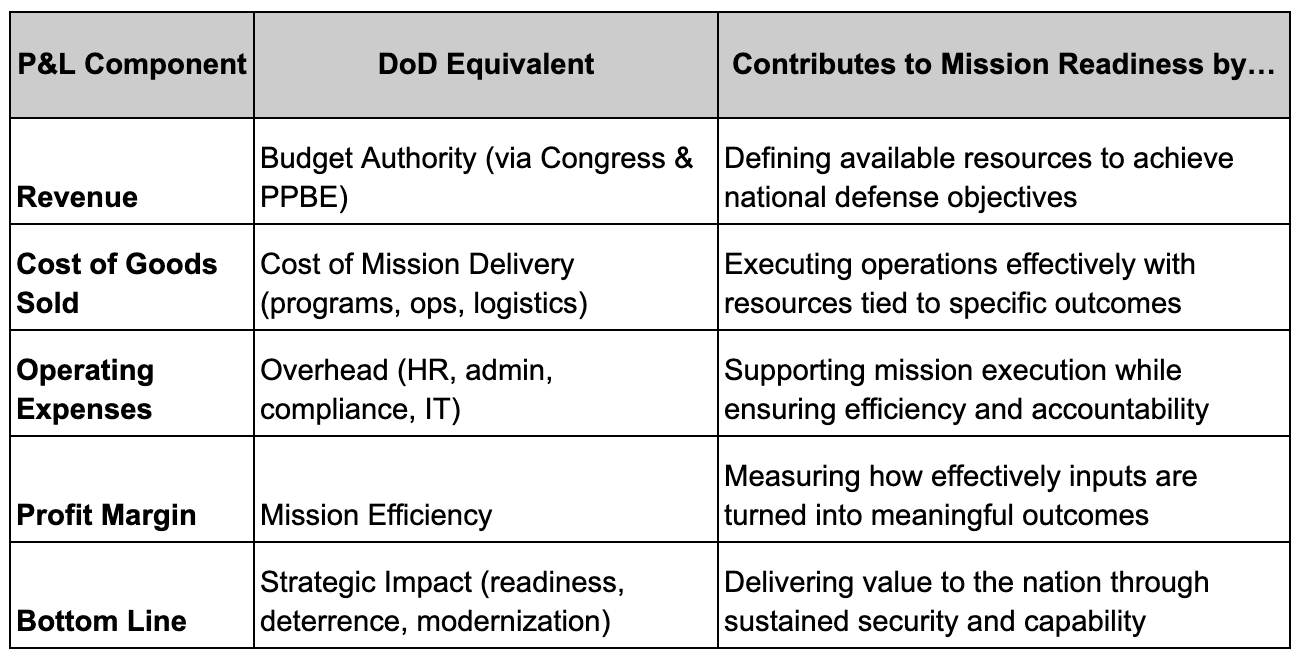Bringing a P&L Mindset to the Mission: Lessons for DoD Leaders from Industry
In a recent interview, I was asked about my experience managing Profit and Loss (P&L) statements. It was a familiar question from my time in the private sector—but it made me pause. Not because I lacked the experience, but because the P&L isn’t a standard tool in the Department of Defense. That got me thinking: How can a leader from industry transition into the DoD and still apply the same drivers that a P&L would sharpen in a commercial context?
In the private sector, a P&L statement is a core management tool. It summarizes a business’s revenues, costs, and expenses over time, giving leaders a clear snapshot of financial health. More than a spreadsheet, it’s a decision-making framework—used to assess performance, set priorities, allocate resources, and communicate value to stakeholders. A good leader doesn’t just read a P&L—they use it to lead.
So how does this translate to the DoD, where the mission—not margin—is the bottom line?
Here’s how I think about it: while government doesn’t aim for profit, it is absolutely accountable for value delivery. And that’s where the P&L mindset becomes powerful. It helps leaders ask—and answer—the question: Are we delivering mission outcomes efficiently and effectively?
Let’s break that down—with DoD equivalents in mind:
“Revenue” = Budget Authority
Example key players: Congress, OSD (Comptroller), Service Budget Offices, Program Executive Offices (PEOs)
This is the funding allocated by Congress through the Planning, Programming, Budgeting, and Execution (PPBE) process. It’s your top-line resource and reflects the trust placed in your organization to achieve specific outcomes.
Cost of Mission Delivery
Example key players: Program Managers, Acquisition Teams, Logistics Commands, Defense Agencies (like DLA, DISA), and Operational Units
This includes all the direct costs needed to execute the mission: systems acquisition (e.g., through the Defense Acquisition System), lifecycle sustainment, force deployment, contractor support, and day-to-day ops.
Mission Efficiency
Example key players: Operational Commands (COCOMs), Joint Staff (J8), Cost Analysis & Program Evaluation (CAPE), Inspector General, and Performance Improvement Officers
Here’s where efficiency is measured. Are programs meeting schedule and cost baselines? Are readiness targets being met without duplication or waste? Tools like Earned Value Management (EVM), readiness metrics, and audit trails all come into play.
Operating Overhead
Example key players: Administrative Staff, HR/Civilian Personnel Offices, Compliance Offices, Financial Management Teams, and IT Support Functions
Every organization has overhead—whether it’s the cost of complying with regulations, managing personnel systems, or running internal processes. These costs are necessary but must be constantly evaluated for streamlining and modernization opportunities.
Strategic Impact = Your “Bottom Line”
Example key players: Service Chiefs, COCOMs, OSD Policy, National Security Council, Congress
This is the true return on investment: mission readiness, deterrence capabilities, modernization progress, strategic presence, and ultimately the advantage of the joint force. Strategic reviews like the National Defense Strategy (NDS), Joint Warfighting Concepts, and Integrated Deterrence frameworks guide what success looks like here.
Here’s a quick breakdown of how I see this fitting together:
So Why Bring a P&L Mindset to the DoD?
A traditional P&L lens won’t—and shouldn’t—replace the formal systems that guide defense resourcing, like the Planning, Programming, Budgeting, and Execution (PPBE) process or the Joint Capabilities Integration and Development System (JCIDS). These frameworks are essential for long-range planning, statutory compliance, and cross-service coordination (one could argue these frameworks also need a lot of improvements - but that’s another post). But they often lack speed, flexibility, and real-time clarity—three things private-sector leaders rely on to make fast, data-informed decisions in dynamic environments.
This is where the P&L mindset becomes a valuable complement.
Think of it as a practical, leader-driven overlay that helps sharpen focus at every execution level, from the front office to the flight line. It encourages leaders to treat each dollar as an investment in mission capability. It forces tough trade-off conversations grounded in cost-benefit realities. And it empowers teams to link spending directly to outcomes, not just activities.
A P&L mindset also helps break down silos. Instead of viewing functions like logistics, IT, acquisition, and program management as separate cost centers, it encourages an integrated view of how all parts of the enterprise contribute to mission output. That shift is critical in an era where operational speed, cross-domain integration, and joint force readiness matter more than ever.
At its core, P&L thinking is mission thinking. It’s not about chasing profits but delivering outcomes with precision and integrity. It starts with being an exceptional steward of taxpayer dollars, treating every resource as an investment in national security rather than just a line item to spend. It means driving operational precision by leaning on data, metrics, and insights that help leaders make timely, informed decisions. It’s about delivering maximum value to the warfighter and the nation, ensuring that every dollar, every program, and every initiative is contributing directly to readiness, deterrence, or strategic advantage. And just as importantly, it shifts accountability beyond mere compliance. Instead of simply following the rules, leaders adopt a mindset focused on measurable impact, where success is defined not by activity alone, but by the value delivered on behalf of the American people.

